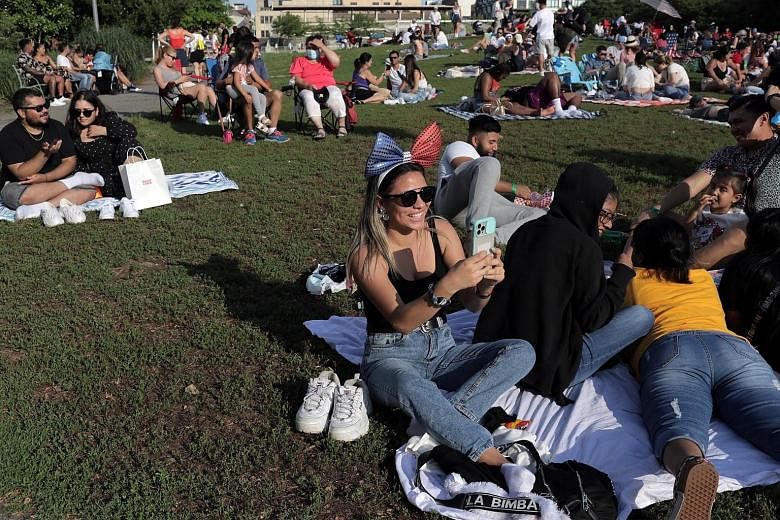It shouldn't be a contest. But that's what it certainly looks like from the growing number of global rankings scoring countries on how well or poorly they are faring in the long march out of the pandemic.
The Economist this month released its Global Normalcy Index, a measure of how close to or far away economies are from their pre-Covid-19 norms.
Ranking 50 countries and territories that together account for 76 per cent of the world population and 90 per cent of global gross domestic product, the index focuses on three key types of activities: travel, leisure and business.
On travel, it measures levels of road traffic, public transport use and flights. On leisure, it tracks time spent outside of homes, cinema revenues and attendance at sporting events. On business, it considers footfall in shops and offices.
Broadly, the index shows that life is more than halfway back to normal levels, at a value of 66 against a pre-pandemic norm of 100.
Around the world, time spent away from home or in the office, retail activity and use of public transport are almost entirely back to normal - regardless of movement restrictions - although air travel, film takings and sports attendance are still less than a third of what they were before the pandemic.
SURPRISING RESULTS
A closer study of individual economies, however, shows marked differences, with some seemingly alarming findings for those in the Asia-Pacific region.
Of the 15 Apac countries and territories tracked in the index of 50 economies, eight were ranked at the 40th spot and below. India, Taiwan and Malaysia occupied the last three spots. Singapore - known for its strong containment measures and high vaccination rates - came in at No. 43.
In the top three positions are Hong Kong, New Zealand and Pakistan. Hong Kong scored 96.3 on the normalcy index. Bottom-most Malaysia scored 27.3.
Malaysia's score can be attributed to its nationwide lockdown, now in its third month, as it grapples with all-time highs in new Covid-19 infections and deaths.
The harsh measures are set to stay until the daily caseload falls below 4,000. It was a record 9,180 yesterday, having risen drastically over the past fortnight.
Notwithstanding Malaysia's tight movement restrictions, the index shows the time its residents spend away from home is at a level of around 70 and office use is near 50.
This indicates that individuals' behaviours may not be in total sync with government measures and could reflect, in part, their perception of how high the Covid-19 threat really is.
In essence, the normalcy index provides some insight into how severely each country or territory's leaders and their people perceive the Covid-19 situation to be, hence influencing their policies and behaviour.
The less dire a government and a population perceive the situation to be, the higher they will likely rank on the index.
Consider Israel, which - despite having fully vaccinated nearly six in 10 people and lifted all movement restrictions last month - ranks only ninth on the index with a normalcy score of 80.4.
Road traffic and use of offices and public transport in the country hover only in the 70s and 80s as its residents continue to live differently from normal times.
Some movement restrictions were reimposed this week due to growing cases, but their impact on behaviour has yet to be accounted for in the index.
Compare Israel with Hong Kong, New Zealand and Pakistan, the top three places with 23 per cent, 10 per cent and 2 per cent of their respective populations fully inoculated. Although some movement and business restrictions remain, they have seen participation in a number of activities rise above even pre-pandemic levels.
Pakistan, in particular, recorded scores of as high as 120 for retail activity, public transport use, office footfall and time spent away from home.
But the country is just starting to see a sustained rise in infections this month and may soon see more deaths as well, given its low vaccination rate.
RANKING LIMITATIONS
The Economist ranking may lead one to presume that economies should be working their way towards pre-pandemic normalcy, or that all are doing so. But that's not necessarily the case, as those who could work from home choose to continue doing so, and some businesses like cinemas may never fully recover, with more new films screening on subscription platforms like Netflix.
"The index assumes that normalcy means a return to 2019," Dr K. Srinath Reddy, president of the Public Health Foundation of India, told The Straits Times. "Some of the changes that the pandemic has brought may stay on. Working from home, e-commerce and telemedicine will not fade away as the pandemic recedes."
Moreover, the index - like many other Covid-19 recovery rankings - appears to be framed more for affluent countries.
"It is not relevant to many other (poorer) nations," Dr Reddy said.
"The normalcy index does not account for any return of lost jobs or narrowing of economic inequalities that have markedly widened between and within countries during the pandemic. Neither does it measure food nor income security."
Other global measures like Nikkei's Covid-19 Recovery Index and Bloomberg's Covid-19 Resilience Ranking do not account for these factors as well.
Nikkei's index, released this week, ranks economies on their recovery progress based on how well they manage their infections, vaccination rates and the stringency of their restrictions.
Bloomberg's ranking tracks a dozen factors including mortality rates, community mobility and economies' openness to the rest of the world.
While these rankings offer valuable insights into the world's journey out of the pandemic, they could also put pressure on the economies lower down the list to prematurely exhibit the same levels of recovery as those ahead, typically richer ones. This will potentially force governments' hands before they can ensure their societies are adequately protected against the virus.
Countries faced with new outbreaks, but are anxious to continue enjoying the economic benefits, may similarly be pressured into staying open even as infections surge while vaccinations remain low.
STRATEGISING A WAY OUT
A good exit strategy includes providing people with clear, measurable milestones to work towards, say experts.
Singapore, for example, has announced plans to further ease its restrictions once at least half its people are fully vaccinated, expected around the end of this month. Fully inoculated individuals may also be able to attend bigger gatherings.
About 40 per cent of the population have been fully inoculated so far.
Hong Kong has already tied greater freedom to vaccinations, by lifting dine-in limits for restaurants where all staff are fully inoculated and at least two-thirds of their customers have had at least one jab. But it has not indicated any specific target towards further relaxation of its measures for the broader populace, saying only that they could be eased if more people are vaccinated.
Only about one in five of Hong Kong residents has received both shots, though it has a surplus of the much sought-after vaccines.
Australia, meanwhile, has a four-stage path out of the pandemic, which also promises more freedom with vaccination. But its strategy lacks clear targets on exactly how many jabs it will take for the economy and society to further reopen, and a timeline on when this can be expected to happen.
The crux, however, should not be how close to pre-pandemic norms a country or territory is at this point in time, or how swiftly one can return to such normalcy; but rather, how to ensure that it can return to a high level of normalcy for good.
Dr Thira Woratanarat, a public health expert at Chulalongkorn University, said a return to normalcy is likely to occur only when disease transmission is well controlled, strong healthcare and screening infrastructure, comprehensive safety protocols and a vigilant surveillance system are present, and a high proportion of people are fully vaccinated.
For countries still struggling to get a handle on their outbreaks - most of them less well-off nations - discussing exit strategies seems like a luxury.
As their inoculations lag those of the richer states and more potent variants of the virus abound, these countries have to stay all the more focused on strict social distancing, tracing and containing infections, and supporting the healthcare system - at the expense of their economies.
Part of a good exit strategy could also include "counting only serious cases, which can provide a good measure of epidemic severity and whether a country's outbreak is advancing or receding", India's Dr Reddy said.
As wealthy nations progressively leave the pandemic behind, plodding steadily towards herd immunity, anger will grow as poorer states suffer under prolonged lockdowns and more people die from a lack of jabs.
Said Dr Reddy: "The vaccinated high-income countries may return to normalcy earlier than the rest of the world, but they will be in a bubble of their own.
"They may have to convene exclusive meetings of their privileged club for two to three years more - perhaps by setting up a V-7 or V-20 to demarcate their status as the vaccine aristocracy."


